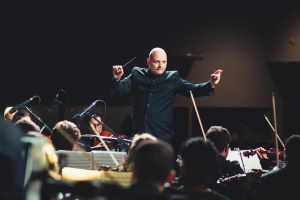To use change to increase growth, performance and the health of your organization you need strong committed leadership. It is an essential element.
I have seen organizational leaders demonstrate change leadership. But one that stands out for me, didn’t come from an organizational leader. It came from a junior high school band leader.
It was the first day, of a regional music program. The program brought together 80 students (between the ages of 12 and 15) from all across the province. In just three days these young people would transform from individual musicians to a band. And they would perform in a concert for over 200 family, friends, and the general public. I was there because my daughter had been chosen to participate.
 Identify Your Critical Mass
Identify Your Critical Mass
The stage was noisy as 80 students and their teachers settled in. They were talking, tuning their instruments, moving chairs, and getting to know each other.
The conductor, a local band teacher, walked on the stage. He quietly surveyed the group. Then picked up his baton. He tapped it a few times. He started talking to the students who had noticed and were paying attention to him.
Slowly more of the young people turned their attention to him. He continued to engage with the students, as he took out his trumpet. He quietly and gently placed it on the stool beside him. The students who had been listening began shushing and telling the other students to be quiet and pay attention. The students continued to do this until the stage was quiet and he had their full attention.
That’s the first action – work from a readiness mindset. Identify and work with your critical mass who will adopt the new activities and behaviours. They will help you engage the others.
Create your Intended Outcome Story
Once he knew he had the students’ full attention, he began to tell a story. Not just any story. He described what they would look like, sound like, and most of all feel like in three days when they had transformed into a band. He described the applause from their parents and others in the audience. He talked about the music. He described the sense of accomplishment they would feel as they played their encore piece.
That’s the second action – create and communicate an outcome story with the people involved. A story that is meaningful, motivating and realistic. One that enables the people affected to see themselves as part of and contributing to the desired outcome.
After that first day, all my daughter talked about was the concert. It wasn’t the band leader’s story anymore, it was their (the students) story.
I know organizations are not a junior high band. However, the principle is the same. Without a clear and compelling intended outcome we won’t let go of what we know.
A clear, concise, and concrete outcome story is necessary, but not sufficient to enable change.
Create a Flexible Plan With the People Affected
Successful change leaders know every change is a process. Letting go of what we know to adopt something new is uncomfortable. It also takes time, effort, and commitment.
The band leader also knew this. He didn’t sugar coat what would be required to achieve the outcome. He described the effort and work that would be needed. He also described what the students could expect from him and the other teachers/coaches. Then he asked for their commitment. Together they created a plan.
That’s the third action – work with the people who will need to adopt the new activities to create a flexible transition plan.
A plan is just that, a plan. Change rarely, goes exactly as planned. That’s why your plan needs to be flexible. A flexible plan responds and adjusts for the level of readiness and energy of people doing the heavy lifting.
Move With The Rhythm of Readiness
It was day three, the last day before the concert. The students were tired and some were having doubts about their capability.
That’s when the band teacher, other teachers and parents’ support really matter. Instead of pushing the students harder, he gave them more breaks.
He worked with the students more closely. When a student was struggling first he gave them instruction. Then when the students were having difficulty creating the sound, he demonstrated it for them. And if that wasn’t enough he worked side by side with them. He also created peer to peer support, students helping students.
That is the fourth action – work with the level of readiness. Identify and adjust the support people need as they take the journey.
It’s rarely possible to achieve an organizational transformation in three days. They are more complex and riskier. That’s why you need skilled change leaders throughout your organization.
Leaders who understand and can work with the normal human response to change. Who focus on building readiness instead of managing resistance. Who know the what’s needed to enable healthy organizational change.
Would you like help developing strong, committed, and skilled change leaders? Contact us today.



